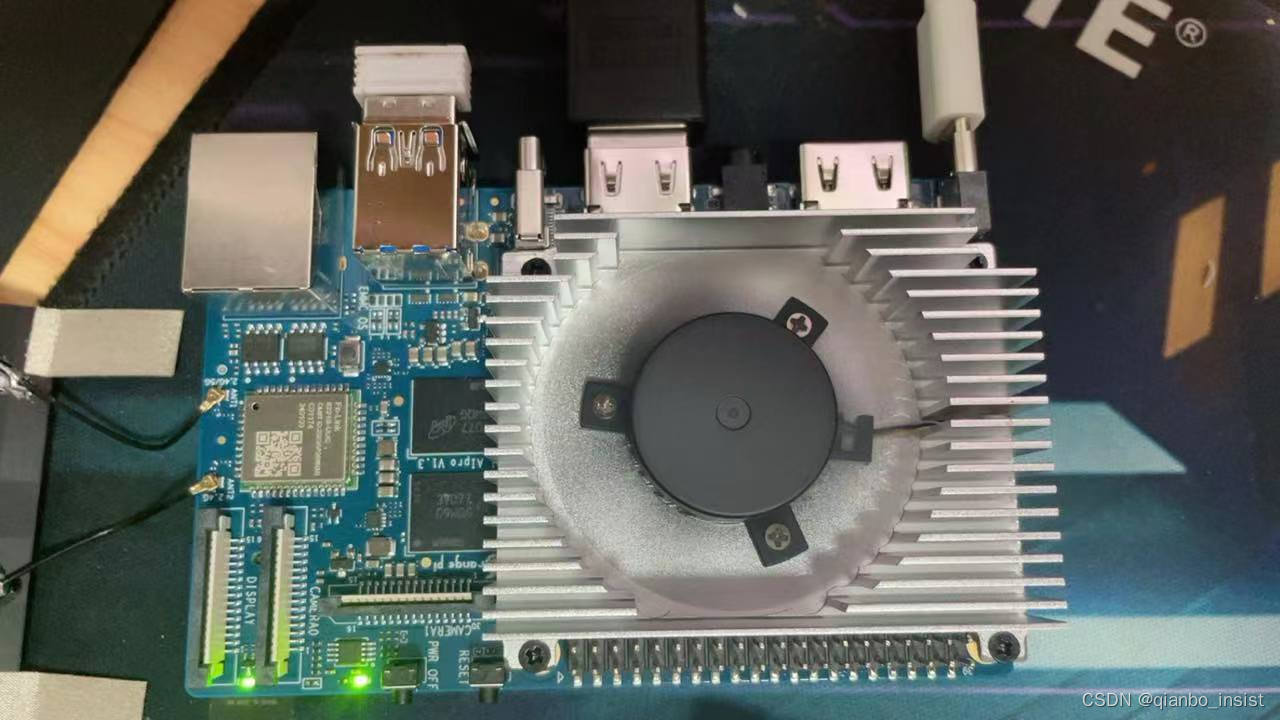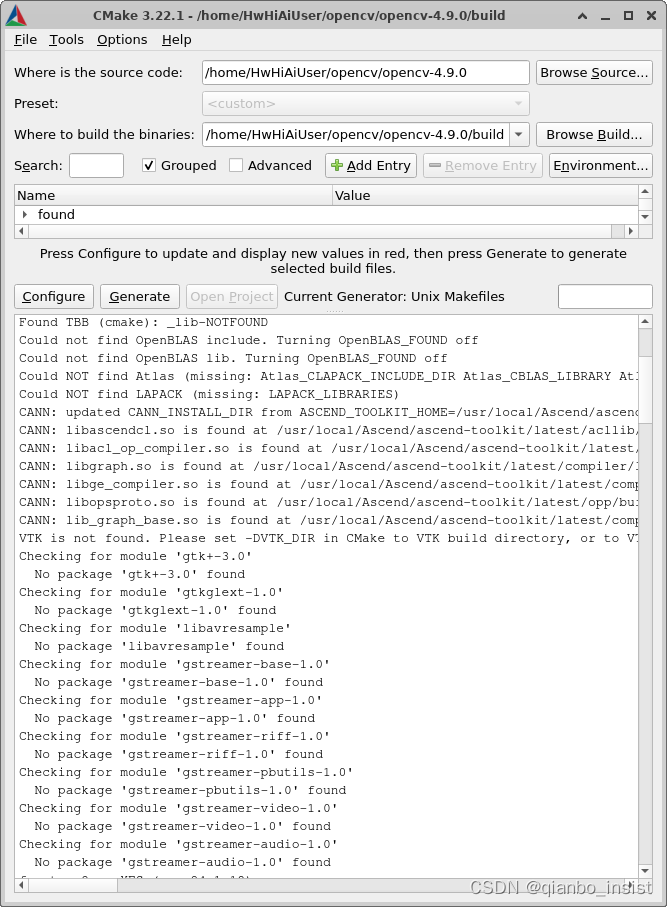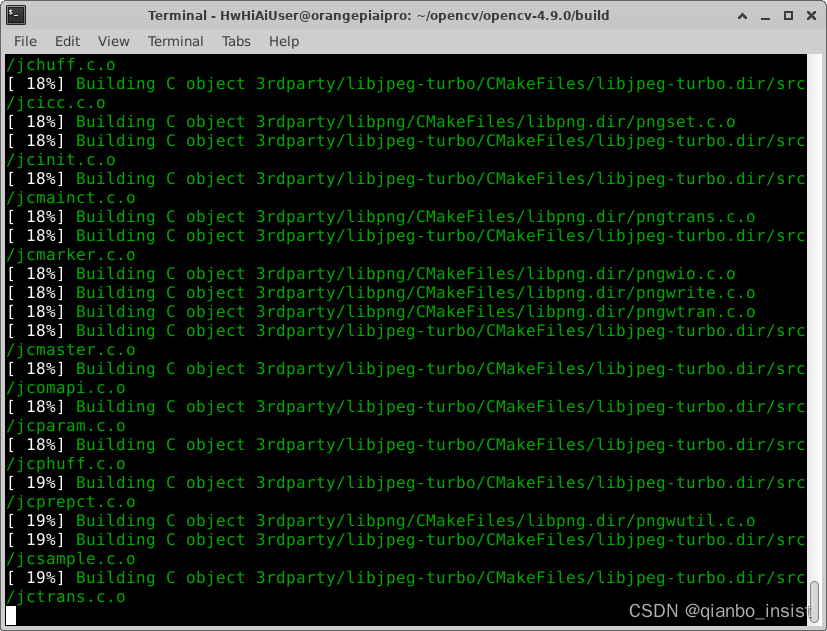香橙派华为升腾AI盒子
为啥要编译opencv4.9.0, 因为在4.9.0 中增加了华为昇腾CANN的外接开发库,下图为盒子外观,此次一接到这个盒子,立刻开始开箱操作,首先就是要编译opencv4.9,以前在香橙派3588 的盒子中,也是同样的操作,不过当时编译的是4.6

华为昇腾CANN架构的优点我也不多说,昇腾AI视频转码解决方案搭载昇腾310处理器,硬件自带编解码及AI处理能力,编解码场景性价比提升最高可达75%,为编解码场景提供高性价比算力,AI 前面一定是视频解码后进行识别,同时转编码发送出去,利用gstreamer,ffmpeg,都可以编解码,但是如何最大化利用硬件资源,需要我们探索。
升级
以下这两部可能需要一些时间,升级时会找到华为云
sudo apt update
sudo apt upgrade
过程中可能会安装一些开发包,比如下面的tbb,不过下面的命令还是执行一下,根据我观察,ffmpeg等库都会安装,需要注意的是一定要把opencv-gui的界面关闭,如果我们是一边安装升级操作,一边编译,达不到效果,因为升级改变了很多库和环境变量。
安装eigen
eigen是一个
sudo apt-get install libeigen3-dev

安装tbb开发包
TBB全称Threading Building Blocks,是Intel针对基于多核处理器进行软件开发而创建的一套C++模板库,核心作用是用来在任务处理中做多线程加速,所以一定要安装tbb,以使用多核并发能力。
sudo apt-get install libtbb-dev
写一个测试程序
#include <tbb/tbb.h>
#include <iostream>int main() {tbb::task_scheduler_init init; // 初始化TBBtbb::parallel_for(0, 10, [](int i)std::cout << "Hello from thread " << std::this_thread::get_id() << " with index " << i << std::endl;});return 0;
}
安装gstreamer 开发包
sudo apt install libgstreamer1.0-dev libgstreamer-plugins-base1.0-dev
安装cmake的界面版本
sudo apt-get install cmake-qt-gui
配置好以下界面

WITH-CANN
重点来了,昇腾为后端的图像处理接口封装在 OpenCV 扩展包(opencv_contrib)的 cannops 模块中,包括图像矩阵的算术运算、通道拆分合并、图片裁剪、翻转、调整大小、转置等图像处理的 Python 和 C++ 接口,处理精度与 CPU 后端的计算结果相同。

 CANN 的勾打上以后,ascend 中的toolkit包会找到
CANN 的勾打上以后,ascend 中的toolkit包会找到
开始编译

CANN c++ 示例
#include <iostream>
#include <opencv2/imgcodecs.hpp>
#include <opencv2/cann.hpp>
#include <opencv2/cann_interface.hpp>int main(int argc, char* argv[])
{cv::CommandLineParser parser(argc, argv,"{@input|puppy.png|path to input image}""{@output|output.png|path to output image}""{help||show help}");parser.about("This is a sample for image processing with Ascend NPU. \n");if (argc != 3 || parser.has("help")){parser.printMessage();return 0;}std::string imagePath = parser.get<std::string>(0);std::string outputPath = parser.get<std::string>(1);// read input image and generate guass noise//! [input_noise]cv::Mat img = cv::imread(imagePath);// Generate gauss noise that will be added into the input imagecv::Mat gaussNoise(img.rows, img.cols, img.type());cv::RNG rng;rng.fill(gaussNoise, cv::RNG::NORMAL, 0, 25);//! [input_noise]// setup cann//! [setup]cv::cann::initAcl();cv::cann::setDevice(0);//! [setup]//! [image-process]cv::Mat output;// add gauss noise to the imagecv::cann::add(img, gaussNoise, output);// rotate the image with a certain mode (0, 1 and 2, correspond to rotation of 90, 180 and 270// degrees clockwise respectively)cv::cann::rotate(output, output, 0);// flip the image with a certain mode (0, positive and negative number, correspond to flipping// around the x-axis, y-axis and both axes respectively)cv::cann::flip(output, output, 0);//! [image-process]cv::imwrite(outputPath, output);//! [tear-down-cann]cv::cann::resetDevice();cv::cann::finalizeAcl();//! [tear-down-cann]return 0;
}
可以用下面的方式来编译
g++ pkg-config opencv --cflags test.cpp -o test pkg-config opencv --libs
其他总结
这块小盒子本身带了一些例子,不过我们最需要的是如何发挥他的关键,就是硬件资源调度,在教育、体育、安防、交通、医疗等领域中,AI检测应用发挥着至关重要的作用,比如在各种安全分析,各种体育训练时的实时人体关键点检测可以精确、实时地捕捉运动员的动作,在安防应用场景中,识别各种异常现象和异常行为或特定姿态,以达到场景安全防控的目的。















实现伪闭包延长连接生命周期)



